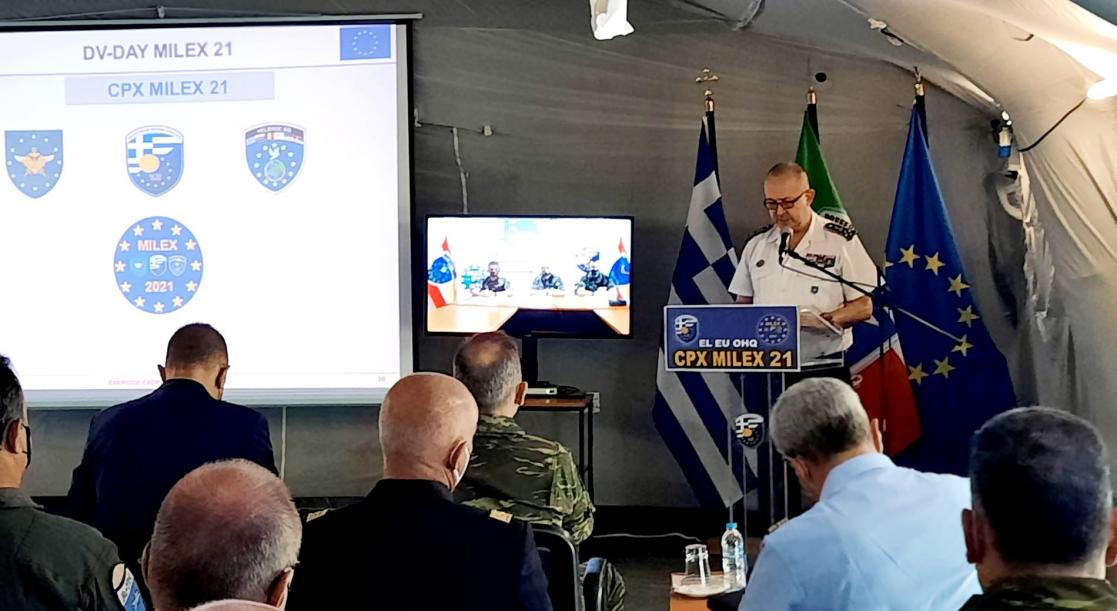EU MILITARY EXERCISE – MILEX 21

On 07 June 2021 personnel from the European Union Military Staff, as well as augmentees drawn from several EU members states arrived in the Greek city of Larissa to take part in the EU’s annual Crisis Management Military Exercise or MILEX.
This iteration of the exercise, designated “MILEX 21” was a CSDP planning exercise pitched at the military strategic (OHQ) and operational (FHQ) levels. It is a Command Post Exercise incorporating a Preparation Phase and a Conduct Phase. The exercise scenario was based on a CSDP military operation, and it focussed on the decision-making, planning, coordination and co-operation aspects of the processes.
This exercise is an excellent opportunity to not only test and evaluate the EU’s structures and operating procedures, but also to exercise and evaluate the human interface that drive them. The exercise also underlines the importance placed on Europe's ability to foster peace and safeguard security within and beyond its borders.

Arrival of MILEX 21 participants to the EL EU OHQ, Larissa
MILEX 21 addresses the EU current and future security and defence needs by enhancing its strategic autonomy and its capability to act as a credible global security provider. The exercise was pitched at the level of ambition prescribed by the EU Global Strategy and was conducted from over a two-week period, concluding on 18 June. The prescript scenario and operational planning documents for this exercise triggered a Joint Stabilization Operation, integrating features derived from the Illustrative Scenarios for Stabilization and Support to Capacity Building, and Conflict Prevention.
The scenario sees a fictitious country called SEGLIA struggling to maintain its security. A terrorist group called NEXSTA, who operate from a safe haven in a neighbouring country, are the main instigators of this insecurity. This group spread terror and impose its rule on villages that are not under the protective umbrella of SEGLIA security forces. The actions of terrorist and criminal organisations are extending to the Seglian territorial waters and threating its Sea Lines of Communications. Internally, institutional corruption, unequal distribution of health and social services, mismanagement of porous borders, migration flows, and a spike in criminal organisations engaging in activities such as illegal traffic and smuggling, need to be addressed. The issues outlined underline the importance of adopting an Integrated approach to conflict management and military assistance is a strand of this approach.
The EU, as part of its Global Strategy, has a fundamental interest in the peace, stability and prosperity in this region. Therefore, when the President of SEGLIA formally submits a request for assistance to the UN SG and the HR/VP, a decision is made to address this situation. This is the start point of this exercise.
During MILEX 21 a group of experts from the European External Action Service (EEAS, including EUMS, ESDC), European Commission (DG ECHO, DG INTPA), SATCEN, MNGSG, the UN HQ, the Athens Multinational Sealift Coordination Centre (AMSCC) and the Hellenic OHQ and FHQ were involved in this exercise.

MILEX 21 utilises all available media to create a realistic scenario.
The main deliverable from the exercise, was a Concept of Operations (CONOPS) that was aligned and harmonized by the military Hellenic EU OHQ to operate in the country affected by an emerging crisis.
The Hellenic EU Operation Headquarters (EU OHQ) and the Hellenic EU Force Headquarters (EU FHQ) were located in Greece (Larissa and Nea Santa Kilkis).
The EU Operations Commander (OpCdr) was Commander Hellenic First Army (HFA) and the EL EU OHQ Lieutenant General Petros DEMESTICHAS. Augmentees from Member States reinforced the core EL EU OHQ staff.
The EU Force Commander (FCdr) was Commander 71 Airmobile Brigade, the HELBROC BG, and the EL EU FHQ Brigadier General Vasileios TSAMIS. Augmentees also reinforced the EL EU FHQ.
As with all other MILEX exercises, the Directing Staff in Brussels, supported by a remote liaison element in location, provide the necessary oversight and control in order to direct the exercise.
Other important elements of the exercise were the presence of Observers and the Distinguished Visitors Day (DVD). The inclusion of observers at the exercise provided partner countries and organisations an opportunity to get a detailed and unique perspective into how the EU conducts its planning and operational preparation. This not only encourages harmonisation of planning processes, it provides partner countries an insight into how the EU plans and conducts its operations.

Vice Admiral Hervé BLEJEAN addresses EU member states military officials during the DVD.
DG EUMS, Vice Admiral Hervé BLEJEAN, participated in the DVD. During his visit, he had the opportunity to observe the operational planning activities and exchange views with elements from all Branches and the Command Group. In his address, DG EUMS discussed the emerging challenges and threats the EU is now facing. He underlined the importance of cooperation between Member States as a means to deal with these threats and to enhance resilience.
The motivation to conduct exercises such as this underline the importance placed on Europe's ability to foster peace and safeguard security within and beyond its borders. It also reinforces the importance of the evolution of Common Security and Defence Policy (CSDP) structures and the benefits of cooperation and interoperability as a means to deal with current and emerging crisis management.
To this end, there is no doubt but that the exercise objectives were achieved.



